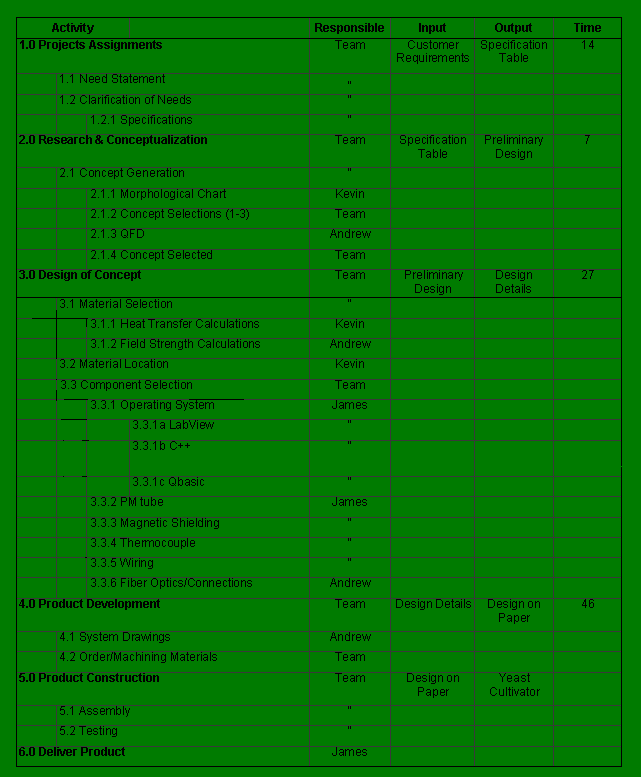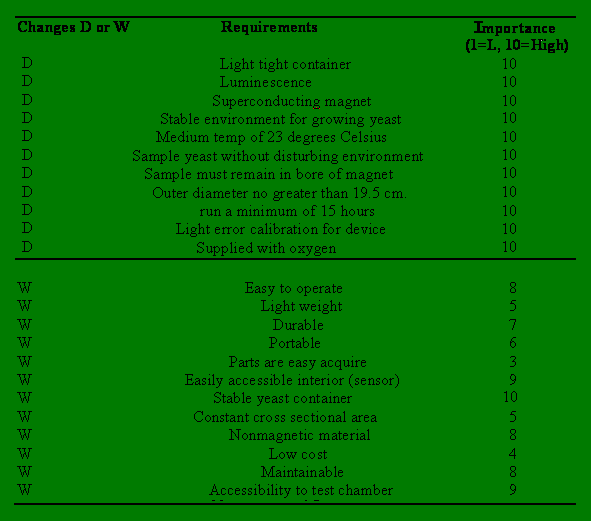Our sponsor, Dr.Haik, requested that a device be designed and built in order to cultivate yeast under a variable magnetic field. This device must be able to measure the luminescence emitted as well as the CO2 released by the yeast while growing. Constant temperature observation of the medium is another measurement requirement of the device. In order to accomplish Dr.Haik's objectives, certain device specifications must be met. First, the environment where the yeast is growing must be "light tight" in order to insure that the photo sensor will not be influenced by external light and, thus, provide for an ideal growing environment. Next, the temperature of the medium must be kept constant to better analyze the system. An increase in temperature will optimize yeast growth and a decrease in temperature will minimize the background count rate. Quickenden and Que Hee were inspired from a long-standing controversy dating back to 1937 debating the existence of a weak UV luminescence emitted by organisms that are not normally classified as bioluminescence. In 1974, Quickenden and Que Hee designed an instrument to determine whether the emissions are due to reactions associated with fermentation or respiration. Experiments were also designed to ascertain whether the luminescence arises from within the yeast itself or from substances secreted into the nutrient medium by yeast growth. Dr.Haik has previously experimentally demonstrated that yeast grows 30% faster when placed in a high magnetic field. A question arises; does the increased growth rate due to the magnetic field increase the luminescence given off by the yeast? Furthermore, do the combined growth rates increase similarly? Our project is to build a device that will allow yeast to grow in a high magnetic field and take measurements of the luminescence emitted by the yeast as it grows. This device will demonstrate weather or not there is a relationship between the increased growth rate of yeast and the luminescence it produces. By designing and producing this device, allows Dr. Haik to continue with his testing to determine solutions to previous questions and offer valuable assistance to the pharmaceutical profession.
![]()

![]()
![]()
A need statement was used to clarify the exact problem from our sponsor and isolate
it from the general situations.
After speaking with Dr. Haik the preliminary need statement was determined.
Upon obtaining the specifications, further research and more discussion with
our sponsor, a revision in the preliminary need statement was required.
Preliminary Need Statement
A light tight device for growing yeast is desired.
The device must be operated in a high magnetic field. The device must also be
able to measure the luminescence produced by the yeast. The magnetic field
strength must be variable. The environment for the yeast must be conducive
for growth. Finally, there should be a way to take samples of the yeast
during the growing process without disturbing the controlled environment.
Revised Need Statement
A light tight device for growing yeast is desired. The device must be operated
in a superconducting magnet with variable high magnetic field. The device must
also be able to measure the luminescence produced by the yeast outside of the
test chamber of the magnet. The temperature of the environment for the yeast
must be 23 degrees Celsius. There should be a way to take samples of the
yeast while remaining in the bore of the magnet (81.93 cm below the top of the
magnet) without disturbing the controlled environment. The device must have an
outer diameter no greater than 19.5 cm. The experiment must be able to run a
minimum of 15 hours; the environment must be supplied with oxygen throughout
the test.
![]()
Along with the needs given in the need statement
there are also other requirements (specifications) that may be met. The
development of specifications may be considered the last step in defining
the problem.The specifications are set in terms of precise limits to quantify what the
design must achieve. The specifications for this design project were broken
down into two listings, preliminary and revised as a result of the change in
need statements. The preliminary and revised specifications are listed in
the table belw.

Specification Table
![]()

Last Revised: 2000-12-20